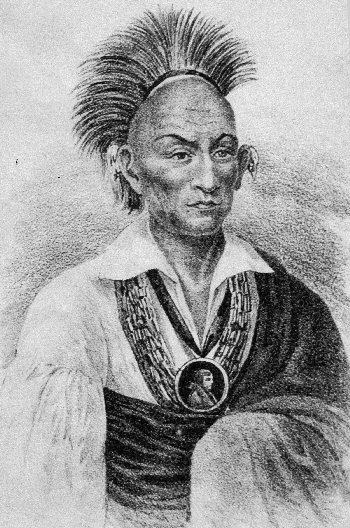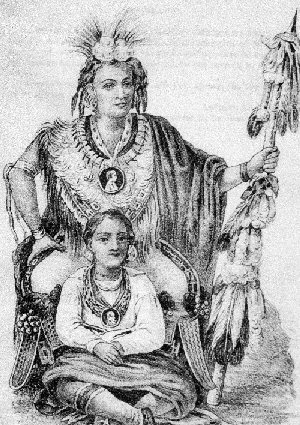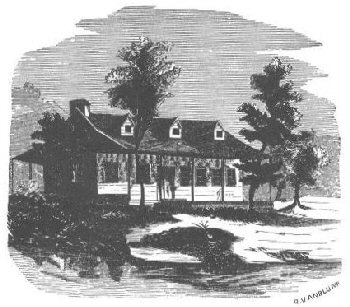
Le Claire City, Iowa
Submitted by Gilles P. Leclaire,(#037),
Translation by Guy Robert, (#168)
Named in honor of Antoine Jr. Le Claire,
Métis, a Mississippi valley pioneer.
This town, established on the Mississippi river, exists because of our common ancestors, Jean Leclerc [I] and Marie Blanquet, Adrien [II] and Pierre [III]. The story begins with Alexis Leclair [IV], captain in the Louiseville militia and his wife Angélique Renaud. We have proof that fourteen children were born from that union. Their fifth child, Antoine Sr. [V], born 15 October 1768, in Louiseville, Québec, was amongst the first pioneers to settle in the Northwest Territories.
We find Antoine Sr. in the County of Fort Joseph, Michigan. Without a doubt, he is involved in fur trading. We strongly believe that three of his brothers: Michel, François and Charles joined him there in search of their fortune in fur trading. They will probably be the subject of a future article. The Michigan territory was then controlled by 50 tribes of the Pottawatwatomie Nation. Antoine Sr. married Marie, the granddaughter of an aboriginal Pottawattamie chief. We are unaware when this marriage took place. However, the births of two boys [VI] were recorded: François, around 1793, and, our focus, Antoine Jr., on 15 December 1797. The latter became the founder the City of Davenport and the owner of the lands on which Le Claire City was later founded.
We find Antoine Sr. in the County of Fort Joseph, Michigan. Without a doubt, he is involved in fur trading. We strongly believe that three of his brothers: Michel, François and Charles joined him there in search of their fortune in fur trading. They will probably be the subject of a future article. The Michigan territory was then controlled by 50 tribes of the Pottawatwatomie Nation. Antoine Sr. married Marie, the granddaughter of an aboriginal Pottawattamie chief. We are unaware when this marriage took place. However, the births of two boys [VI] were recorded: François, around 1793, and, our focus, Antoine Jr., on 15 December 1797. The latter became the founder the City of Davenport and the owner of the lands on which Le Claire City was later founded.
The family then moved to Peoria, Illinois where Antoine Sr. is still involved in fur trading because the lands that he purchased are insufficient to sustain the family. In 1809, he partnered with John Kinsey (John Mackenzie) to establish fur trading posts. John, a French-speaking Canadian from Québec City, was a goldsmith and well-known fur trader, aged 46, who left his family at the age of ten to start his apprenticeship as a goldsmith. He had his own trading post at Fort Dearborn, now Chicago, Illinois. During the War of 1812, he was saved by the Pottawattomie, because he had always been an honest trader, an excellent goldsmith and, without a doubt, because he was a partner of Antoine Sr., who was blood related with the Pottawattomie.
The analysis of the requests made for the property titles in Peoria, Illinois, where Fort St-Louis, held by the French, was built, reveals the following transactions. From 1809 to 1812 the lot number 25 (80 by 300 feet) was occupied by Antoine Le Claire and was sold to him by Joseph Dejeney. In 1802 Antoine Le Claire bought lot number 26 (80 by 300 feet) from Jean-Baptiste Chapedelaine, which he gardened until 1812. In 1812, those two lots were bought by Thomas Lusky. We have no religious records from Peoria. In 1812, during the War between the British and the Americans, Antoine Sr. sided with the Americans. He was made prisoner in Peoria, where he lived, by Captain Thomas Craig and was brought to Fort Alton, where he was released later the same year. He and twelve other French-speaking prisoners from Peoria petitioned the American Congress to obtain compensation for their losses. It was only in 1840 that this affair was settled in their favor.
Later in 1813, we find the family at Portage des Sioux, in Missouri. From that location, we have the religious records of Antoine's Sr. future marriages as well as the christenings and weddings of his children. At that time, he was still involved in fur trading and owned many trading posts, while also working as a blacksmith. In 1816, he was appointed business agent for Indian affairs in the Illinois territory and an interpreter for the Pottawattomie Nation in Peoria, by A. Graham. On January 16, 1819, Antoine Sr. married Félicité Loise, of Spanish origin, in Portage des Sioux, Missouri. They had at least four children. After becoming widow, he later on married Joséphine Boucher. There is no record of any child from this last marriage. It appears that his last place of residence was Portage des Sioux. He is believed to have died in August 1825.
Antoine Jr. Le Claire [VI], our focus here, was born on 15 December 1797 in Fort Joseph, Michigan. Because his mother was a native of the Pottawattomie Nation, he fully experienced the advantages and the hardships of being a Métis. It is said that he established his first trading post in 1808, at the age of twelve, in a location now known as Milwaukee, Wisconsin. A large bronze plaque indicates the site of this trading post at the north-western corner of East Water and Wisconsin streets. He then started to trade extensively with many native tribes. The historians appear to confuse Antoine Sr. and Jr. on events during that period. We believe that Antoine Jr. was involved there because Antoine Sr. was active in Portage des Sioux and Peoria.
Antoine Jr. [VI] Le Claire vit le jour le 15 décembre 1797 à Fort Joseph, Michigan. Comme sa mère était une Pottawattomie, il vécut tous les avantages et inconvénients d’être un Métis. Il est dit qu’Antoine établit son premier poste de traite à l’âge de douze ans, en 1808, pour acheter des fourrures des Indiens, au lieu qu’on appelle maintenant Milwaukee, Wisconsin. Une large plaque de bronze indique le lieu de ce poste de traite, d’Antoine Leclaire sur le coin nord ouest des rues East Water et Wisconsin. Et il commença à traiter intensément avec plusieurs tribus amérindiennes. Les historiens se contredisent entre Antoine Senior et Junior, pour les évènements de cette période. Je suis porté vers Junior car senior sera actif au Portage des Sioux et Peoria.
During the War of 1812, Antoine Jr. met General William Clark, who was impressed by his linguistic abilities. In fact, he mastered many Amerindian dialects. With the influence of General Clark, at the early age of fifteen, he was enrolled and entered a St-Louis, Illinois school so he could perfect the English language and acquire a rudimentary education, with the objective of becoming an interpreter. At the age of twenty, he was appointed as an official interpreter by the United States Government. This was an excellent decision, because he became one of the best interpreters in the country, if not the best. It was said that he spoke three languages: French by his father, English and Spanish by his step-mother as well as fourteen Amerindian dialects.
In 1818, at the age of 21, Antoine Jr., renowned as representing two races, a man of great integrity and overflowing energy, was elected as official interpreter for Colonel George Davenport, based at Fort Armstrong at Rock Island, Illinois, now called Arsenal Island . Later on, the two men became friends for life. Antoine Jr. built his shelter just outside the fort. At 23, he married Marguerite Lepage, born 16 October 1802 in Portage des Sioux, St-Charles County, Missouri. She was the granddaughter of Acoqua (The Kettle), chief of the Sacs tribe, and the daughter of Antoine Lepage, killed by Little Crow. Antoine Jr., a Métis, was marrying another Métis. They did not have any known descendants.
As a wedding trip, his superiors sent him and his wife Marguerite to Arkansas to spy on the movements of Amerindian tribes. They did that for seven years, because they were back at Fort Armstrong in 1827. At that time, the region was part of three territories: Michigan, Wisconsin and Iowa. In 1829, the Government bought back the properties from the Amerindians in the Lake Michigan region. As Métis, Antoine Jr. and his brother were granted a quarter section of valuable land on the Mississippi river starting in Moline.
He was the interpreter at Black Hawk's treaty signing, when the Sacs and Foxes tribes sold the lands west of the Mississippi to the Americans. Later, Antoine was asked to translate his life's story; the book written by J.B. Patterson and published in 1833 was a success at the time. Keokuk, the Sacs's Grand Chief who had kept a two square mile section of land, gave it to Mrs. Leclaire on the condition that Antoine would build his home on the spot that General Winfield Scott had marked when signing the treaty. ntoine fulfilled this condition to the letter and thus became the first pioneer to settle in Davenport, Illinois. The house was later used as a Post Office and a railway station.
The Sacs and the Foxes also gave him a two mile long piece of reserve land on the other bank of the Mississippi, in Iowa territory, at the head of the rapids, where Le Claire City is now located. In the Paririe du Chien, treaty, the Pottowttomie also set aside two sections of land located on the Illinois side, later designated as the Le Claire Reserve. It is the location of the present City of Moline. He was the interpreter for at least twelve treaties between the Amerindians and the Americans, as he was valued by both whites and Indians. In return, the Government gave him a section of land facing Rock Island and another one at the head of the first rapid downstream from Rock Island. This was the first Iowa piece of land conceded to an individual by the United States.
Antoine Jr. founded the city of Davenport, naming it in honor of his friend Colonel George Davenport. He was also instrumental in the erection of the cities of Le Claire, Rock Island and Moline. Antoine had built a manor which was used for every important gatherings at the time and that still can be visited today. Buffalo Bill Cody was born in Le Claire City in 1846 and you can learn about him today in the Buffalo Bill Cody Museum there.
He was named Davenport's Postmaster in 1833 and Justice of the Peace for the region, where he settled disagreements between whites and Indians. He bought surveyed pieces of land in the City of Davenport, offered to him on a silver platter, for $100. In 1834, he initiated the first ferry on the Mississippi to commute between his Iowa and Illinois estates. In 1836, he built a hotel, the Leclair House, where all the important gatherings of the time were held. He was one of the promoters for the railway and in 1853 a locomotive was christened Antoine LeClaire, in his honor; it was said that it was the best locomotive in the United States. He was one of the builders of the first bridge on the Mississippi in 1854, of the foundry etc. He was a strong promoter of real estate for the region.
Antoine and Colonel George Davenport were very close and, together, they developed the County of Scott. Amongst others business ventures, Davenport was a partner in the American Fur Company. A book could be easily written to chronicle all of Antoine Le Claire's achievements.
He became the first president of the Scott County Pioneer Settlers' Association, on or before 31 December 1846.He invited his friend Keakuk, Sacs' Grand Chief, to become a member; which he accepted.
When Colonel Davenport was assassinated, the Sacs and Foxes Nations were alarmed for Antoine Leclaire's security. They deployed a large group of warriors to protect the house around the clock and make sure that no harm happened to their beloved family.
On 25 September 1861, Antoine died suddenly at the age of 64 after a third attack of paralysis. Marguerite and he did not have children but they provided food, shelter and education to the children of his brother François. They also looked after the affairs of his wife Marguerite's entire family. She died in her home in Davenport on 18 October 1876. Her remains are buried besides her husband's in the gantry at Ste-Marguerite's Church that they had built. He was a devout Christian and he erected three Catholic churches as well as some for other faiths. He was generous and friendly towards everyone. He liked to entertain them playing his violin and he was an excellent dancer.
Captain Clark, the General's son, said of Antoine, when he first met him, that he was 5 foot, 7 inches tall and that he weighted 175 pounds. He was robust and well-muscled. In 1844, it is said that he weighted 385 pounds. However, this did not prevent him from roaming the countryside; his white horse and his carriage were seen everywhere. It is said that his fortune was in excess of $500,000, a huge sum at the time. Also, Antoine was a simple man, a good neighbor and warmhearted to all. He never asked anyone from what country they were, neither to what tribe they belonged. We know a few descendants from this family and we strongly wish to welcome them as members of our family.

Antoine Le Claire

Black Hawk

Keokuk

Kinzie (MacKenzie) Maison et/and Fort Armstrong.

Le Claire Maison - Davenport

Le Claire Mansion